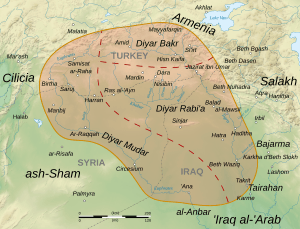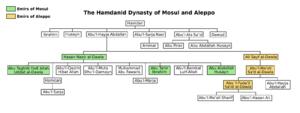Abu Taghlib facts for kids
Quick facts for kids
|
|||||
|---|---|---|---|---|---|
| Emir of Mosul | |||||
| Reign | 967–978 | ||||
| Predecessor | Nasir al-Dawla | ||||
| Born | 940 | ||||
| Died | 29 August 979 (aged 38–39) Ramla |
||||
|
|||||
| Dynasty | Hamdanid | ||||
| Father | Nasir al-Dawla | ||||
| Mother | Fatima bint Ahmad | ||||
Abu Taghlib (full name: Uddat al-Dawla Abu Taghlib Fadl Allah al-Ghadanfar al-Hamdani) was an important ruler from the Hamdanid dynasty. He was the third Emir of Mosul, a region called the Jazira (which is part of modern-day Iraq and Syria). He ruled from 967 to 978.
His time as ruler was quite difficult. He faced many challenges, including fights with his own brothers. He also had conflicts with other powerful groups, like the Buyids, who wanted control over important cities like Baghdad. The Byzantine Empire, led by Emperor John I Tzimiskes, also attacked his lands. Abu Taghlib even got involved in a rebellion by a Byzantine general named Bardas Skleros.
Abu Taghlib's relationship with the Buyid ruler of Iraq, Izz al-Dawla Bakhtiyar, changed often. Sometimes they were friends, sometimes enemies. But they eventually became allies, especially when Bakhtiyar faced his own problems. In 978, the Jazira region was taken over by another Buyid ruler, Adud al-Dawla. Abu Taghlib had to escape to parts of Syria controlled by the Fatimid Caliphate. He tried to become the governor of Damascus there. However, he got caught up in local rivalries. This led to a battle where he was defeated and executed on August 29, 979.
Contents
Who Was Abu Taghlib?
Early Life and Family
Abu Taghlib was born in 940. He was the oldest son of al-Hasan, who was better known by his special title, Nasir al-Dawla. His mother was Fatima bint Ahmad, a Kurdish woman. She was said to have a lot of influence over Nasir al-Dawla's decisions.
His father, Nasir al-Dawla, had made the Hamdanids very strong rulers. They controlled a large, almost independent area called the Jazira, with their main city being Mosul. Nasir al-Dawla often tried to take control of the Abbasid caliphs (religious and political leaders) in Baghdad. But he eventually lost to the more powerful Buyid dynasty. He had to accept their rule and pay them money.
At the same time, Abu Taghlib's uncle, Ali (known as Sayf al-Dawla), became powerful in northern Syria. He ruled from Aleppo and Mayyafariqin. Sayf al-Dawla became very famous for his battles against the Byzantine Empire. However, in his last ten years, the Byzantines defeated him many times. They took over much of his land, and there was a lot of unrest.
Abu Taghlib first appears in history in 964. His father was fighting the Buyids again. The Buyid army took over Mosul, and Nasir al-Dawla had to run away. Abu Taghlib led the fight against the Buyids. They couldn't stay in Mosul and eventually left. A new agreement was made with the Hamdanids. In May 967, Abu Taghlib, with the quiet agreement of most of his brothers, removed his elderly father from power. He imprisoned him in a fortress, where his father died in February 969.
Becoming a Ruler

Abu Taghlib took over from his father as the emir and leader of the Hamdanid family in the Jazira. He was given the special name al-Ghadanfar, which means 'The Lion'. But his rule was immediately challenged by his younger half-brother, Abu'l-Muzzafar Hamdan. Hamdan had not agreed to their father being removed.
Challenges from His Brother
Abu Taghlib asked the new Buyid ruler of Iraq, Izz al-Dawla Bakhtiyar, for help. Unlike his father, Abu Taghlib didn't try to control Iraq. The Buyid ruler was also busy securing his own power. With the Buyids' help, Abu Taghlib forced his half-brother to give up some cities. But then Hamdan convinced Bakhtiyar to switch sides. Abu Taghlib's other brothers also started changing their loyalty.
Even so, Abu Taghlib won. He forced Hamdan to flee to Baghdad. Abu Taghlib took control of the towns his brother held. He also used the chaotic situation in Syria after Sayf al-Dawla's death to expand his territory. By 971, he controlled all of Diyar Bakr and Diyar Mudar. These areas used to be part of Sayf al-Dawla's lands. This meant Abu Taghlib united the entire Jazira region under his rule. The Caliph (the top religious and political leader) even gave Abu Taghlib power over the Hamdanid emirate of Aleppo.
As the ruler of the Jazira, Abu Taghlib was one of the richest leaders in the area. Writers of the time described the great wealth from the Hamdanid lands. One writer, Ibn Miskawayh, who checked the family's mountain strongholds later, wrote about the huge amounts of money stored there.
Dealing with Powerful Neighbors
With his position secure, Abu Taghlib was said to dream of becoming the amir al-umara ('chief emir'). This meant he wanted to be the master of Baghdad and the caliph. Hamdan, his brother, kept trying to turn Bakhtiyar against Abu Taghlib. A conflict was avoided for a while because the Fatimid Caliphate started getting involved in Syria. This made both rulers unite against the Fatimid invasion. As part of this alliance, Abu Taghlib married one of the Buyid ruler's daughters.
In 973, Hamdan finally convinced Bakhtiyar to march north. Abu Taghlib left Mosul without a fight. But his army outsmarted the Buyid emir and briefly threatened Baghdad. They negotiated an agreement. But Bakhtiyar thought it was too good for Abu Taghlib. So, he marched against Mosul again. However, there were no battles, and the conflict ended with a new agreement in 974. As part of this, the caliph gave Abu Taghlib the title Uddat al-Dawla ('Instrument of the Dynasty'). Abu Taghlib also had to pay money to Bakhtiyar.
Facing the Byzantines
During this time, Abu Taghlib also faced attacks from the Byzantines. In 972, Emperor John I Tzimiskes led his army deep into the Jazira. Abu Taghlib got some revenge by defeating and capturing a Byzantine general in 973. But in 974, Tzimiskes himself attacked the Jazira again. After these Byzantine attacks, Abu Taghlib paid money to the emperor for some time.
In 976, after Emperor Tzimiskes died, Abu Taghlib agreed to help a rebel Byzantine general named Bardas Skleros. They made a deal where Abu Taghlib would send light cavalry (soldiers on horseback) to Skleros. In return, they agreed on a marriage alliance, though the details are not fully known.
Alliances and Conflicts with the Buyids
From 973 to 975, Abu Taghlib supported Bakhtiyar in his own struggles to keep power. He marched on Baghdad again during a rebellion by a Turkish commander. However, it was the help of another powerful Buyid ruler, Adud al-Dawla from Shiraz, that helped Bakhtiyar win. Because of his help, Abu Taghlib got a new agreement in 975. This agreement meant he no longer had to pay money to the Buyids.
In November 977, Bakhtiyar was driven out of Baghdad by his ambitious cousin, Adud al-Dawla. Again, Hamdan convinced Bakhtiyar to march on Mosul. Abu Taghlib stopped an attack by promising to support Bakhtiyar against Adud al-Dawla. In exchange, Hamdan was handed over and quickly executed. This secured Abu Taghlib's position, but it also made Adud al-Dawla notice him.
In May 978, Bakhtiyar and Abu Taghlib were defeated in a battle near Samarra by Adud al-Dawla. Bakhtiyar was captured and executed by his cousin. Adud al-Dawla then moved towards Mosul. Unlike earlier Buyid attacks, this one was well-planned. Adud al-Dawla brought experienced officials who knew the area.
End of His Rule
Adud al-Dawla took Mosul in June 978. Abu Taghlib was chased by the Buyids. Adud al-Dawla refused to negotiate with him. Abu Taghlib fled to other cities and then to the mountains. He hoped to find safety. While the Buyids surrounded one of his cities, Abu Taghlib went into Byzantine territory. He hoped to get help from the rebel general Skleros. He defeated a Buyid force in August, but Skleros was also having trouble and couldn't help him much.
After his city fell to the Buyids, Abu Taghlib found safety with his sister in another city. His offers for a peaceful agreement were rejected by Adud al-Dawla. The Buyid ruler finished conquering the Jazira. Abu Taghlib's brothers even started working for the Buyids.
Only one small area remained under Abu Taghlib's control. His situation was becoming very difficult. The Buyids controlled most of the Jazira. Skleros's rebellion ended in defeat in March 979. Abu Taghlib couldn't get help from his cousin, who had already accepted Adud al-Dawla's rule and was ordered to arrest him.
So, Abu Taghlib and his remaining followers crossed the Syrian Desert. They went to the south of Syria, which was controlled by the Fatimids. There, he got involved in the complicated power struggles between the Fatimid government and local leaders. He tried to become the Fatimid governor of Damascus. But a rebel general who held the city pushed him back. Under attack, and with his family members leaving him, Abu Taghlib moved further south.
Abu Taghlib's plans and his connections with the Fatimids now threatened a local chief named Mufarrij. This chief ruled the city of Ramla. A Fatimid general promised Ramla to Abu Taghlib, hoping to cause trouble among the local Arab tribes and strengthen Fatimid power. Abu Taghlib openly allied with Mufarrij's rivals and attacked Ramla in August 979. However, the Fatimid general's troops helped Mufarrij. In the battle on August 29, Abu Taghlib was captured and executed. This was likely done because Adud al-Dawla, whom Mufarrij had recognized as his overlord, wanted it.
The Jazira remained under Buyid control until 989. Then, Abu Taghlib's brothers, who had joined the Buyids, were made governors. They were supposed to fight a Kurdish chieftain. In this fight, the two brothers relied on another tribe. After the chieftain was defeated, this tribe turned on the Hamdanids. They killed Abu Taghlib's brother and established their own rule in the Jazira.
See Also
- Hamdanid dynasty
- Emirate of Mosul
Sources
- Canard, Marius (1971). "Ḥamdānids". The Encyclopaedia of Islam, New Edition, Volume III: H–Iram. Leiden: E. J. Brill. 126–131.
- Canard, Marius (2004). "Abū Tag̲h̲lib". The Encyclopaedia of Islam, New Edition, Volume XII: Supplement. Leiden: E. J. Brill. 36–37.
- Gil, Moshe (1997). [Abu Taghlib at Google Books A History of Palestine, 634–1099]. Cambridge: Cambridge University Press. ISBN 0-521-59984-9. Abu Taghlib at Google Books.
- Kennedy, Hugh (2004). [Abu Taghlib at Google Books The Prophet and the Age of the Caliphates: The Islamic Near East from the 6th to the 11th Century] (Second ed.). Harlow: Longman. ISBN 978-0-582-40525-7. Abu Taghlib at Google Books.
| Preceded by Nasir al-Dawla |
Emir of Mosul 967–978 |
Vacant
Buyid occupation
Title next held by
Abu Tahir Ibrahim and Abu Abdallah al-Husayn |


